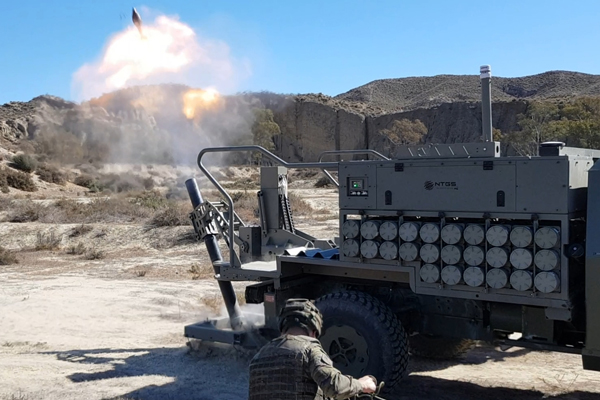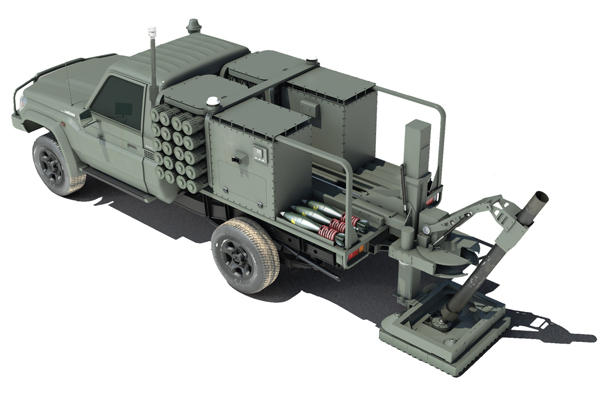- Home
- Feature Articles
- Experimentando con el nuevo Alakran
Testing the new Alakran
Tuesday, August 20, 2019
Number: 91
The army is moving towards its 2035 goals by implementing and testing new equipment which will bring it closer to meeting its future needs. As the driving force behind the experiments for the Force 35 programme, the ‘Alfonso XIII’ Brigade, 2nd of the Legion, has been the pioneering unit in the evaluation of the Alakran, a mortar mounted in a light vehicle, developed by NTGS (New Technologies Global Systems) from the Everis group. The system has an 81/120 millimetre mortar fire capacity, although the tests focused on using 120mm.

Specifically, the 8th Group from the Third ‘Don Juan de Austria’, 3rd of the Legion, was put in charge of evaluating this version, which has been adapted for a High Mobility Tactical Vehicle (VAMTAC, to use its Spanish acronym) S3, provided for the army.
The new system is designed to avoid the recoil effect caused by shooting on the vehicle and is operable for high mobility deployable units. “One of the advantages which the new Alakran offers is the speed of securing the mortar, getting into position and withdrawing,” explains Captain Celma, who was chief of the Mortar Section during the experiment.
It also includes a pneumatic system for the deployment and withdrawing of the mortar, which allows it to fire from the floor. This means that after the shot they can abandon the position in around 30 seconds because it can be done whilst moving once the base plate has been lifted from the floor. Because it is not necessary to fire with the mortar on board, you can move away from it, making it even safer.
The new Alakran can also be mounted on various different platforms and has an automatic firing system.
During the tests they evaluated the possibilities offered by the new Alakran, such as deploying and withdrawing the system and the option of firing on expected and unexpected targets.
They also used the Cardom mortar carrier, with 81mm munitions, which is a benchmark for precision and dispersion.

Each mortar carrier has four occupants, a squad chief, a driver and two attendants. The last two carry out the fire, whilst the chief is in charge of the command and control system.
“Experimenting with the new material and offering our perspective on it is an advantage,” explains Captain Celma.
This new adaptation of the Alakran was on show in the International Defence Trade Fair from the 29th to the 31st of May. Choosing the Brigade of the Legion for its tests represents a further step in the relationship between the Army and businesses, helping to build the Army of the future.
TEST PHASES
The technological demonstrator was present in some workshops carried out between the 21st and 26th of November 2018 in the ‘San Gregorio’ training centre.
Later, on the 14th of January 2019, it was received in the ‘Álvarez de Sotomayor’ base in Almería and, two months later, on the 14th of March it began its first test with live fire in the manoeuvre ground and shooting range in the base.
On the occasion of a visit from the Minister of Defence on the 25th of March, a display of the Alakran’s capacities was carried out. Once the evaluation phase with the Brigade had been concluded, it was finally returned to the company.
Now the company will study the suggestions from the Legion after its evaluation, as well as the possibility of installing the Talos system in the mortar carrier.
DESIGNED TO WORK IN RURAL AND DESERT AREAS
The mortar carrier comes with protection against solar radiation, dust and water.
It also has an integrated meteorological station.
HIGH MOBILITY
It can be installed in vehicles weighing 1.5 tonnes or more, without the need for structural reinforcement.
It can also be transported by helicopter thanks to its reduced weight.
ADVANCED SOFTWARE AND ELECTRONICS
It can be operated from the cabin and from outside the vehicle. The Alakran has its own fire management system, which shows its location as well as those of its assigned targets. It also includes a ballistics calculation system for multiple types of munitions.

HIGH FIREPOWER
The Alakran can be loaded with 52 120 millimetre grenades. It can shoot 12 times in the first minute and 4 in sustained fire.
LOW MAINTENANCE ELECTRO-PNEUMATIC SYSTEM
The Alakran’s electro-pneumatic system is a great advantage because it is lighter and requires less maintenance than a hydraulic system.
QUICK OPERATION
The vehicle is ready to fire in 35 seconds and after firing can be aimed again in just 8 seconds. It can also retreat in 25 seconds.
ARMY UNITS
- Araba Álava |
- Albacete |
- Alicante |
- Almería |
- Asturias |
- Ávila |
- Badajoz |
- Barcelona |
- Burgos |
- Cáceres |
- Cádiz |
- Cantabria |
- Castellón |
- Ceuta |
- Ciudad Real |
- Córdoba |
- A Coruña |
- Cuenca |
- Girona |
- Granada |
- Guadalajara |
- Gipuzkoa |
- Huelva |
- Huesca |
- Islas Baleares |
- Jaén |
- León |
- Lleida |
- Lugo |
- Madrid |
- Málaga |
- Melilla |
- Murcia |
- Navarra |
- Ourense |
- Palencia |
- Las Palmas |
- Pontevedra |
- La Rioja |
- Salamanca |
- Segovia |
- Sevilla |
- Soria |
- Tarragona |
- Santa Cruz de Tenerife |
- Teruel |
- Toledo |
- Valencia |
- Valladolid |
- Bizkaia |
- Zamora |
- Zaragoza



